Term archive
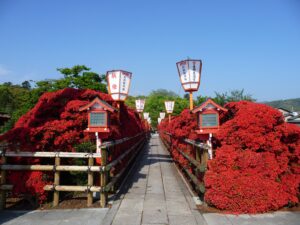
投稿タイプ:sightseeing
Nagaoka Tenmangu Shrine
Nagaoka Tenmangu is a shrine in Nagaokakyo City, Kyoto Prefecture, not far from Kyoto City and close to Uji—the region of Kyoto famous for matcha green tea—and the famous Otokuni Bamboo grove. Nagaoka-Tenmangu is also known as "Mikaeri-tenjin" (a shrine that's "hard-to-leave"), and was dedicated to Sugawara-no Michizane, a Japanese scholar, poet, and politician of the Heian era (794–1185). It is said that Michizane was posted to Dazaifu City (the military and administrative centre of Kyushu at the time), on his way to which he visited the location where the shrine currently stands, and was reluctant to leave. The entrance path to the main hall is lined with hedges of approximately 150-year-old Kirishima azalea trees, which bear distinctive dark red flowers which will be in full bloom beginning in late April, when they create an azalea tunnel. The Kirishima azaleas are also designated by Nagaokakyo City as a protected species. At Nagaoka Tenmangu Shrine there is beautiful scenery to be enjoyed all year round, from cherry blossoms in the spring, lotus flowers in the summer, and Autumn foliage light-up events illuminating Nagaoka Tenmangu Shrine's Japanese garden, Kinkei-en. Next to the Hachijoga-ike Pond there is also a restaurant, Kinsuitei, where you can enjoy the beautiful scenery together with cuisine made using freshly picked young bamboo shoots in the springtime, or other traditional Kyoto cuisine during other times of the year
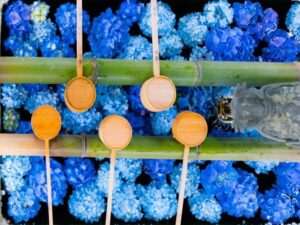
投稿タイプ:sightseeing
Yanagidani Kannon (Yokoku-ji Temple)
Yanagidani Kannon (Yokokuji Temple) is located in Nagaokakyo City, not far from Kyoto City and close to the famous Otokuni Bamboo Grove, where the main attraction is the eleven-faced, thousand-armed statue of the bodhisattva Kannon statue. The temple is built on the side of a mountain, and the inner temple building and main hall are connected by a long corridor surrounded by a Kyoto-designated scenic garden, Jodo-en. On the second floor is the Kamishoin Study, which was once a designated study room for elites during the Meiji era (1868-1912). These days, the study room and its beautiful view of the gardens is open to the public. The Yokokuji Hydrangea Path is a famous place to enjoy hydrangeas and inludes over 4,500 hydrangea plants that bloom in June and in the summer months. In autumn, the deep red carpet of the Kamishoin Study and bright red autumn foliage creates an impressive sight, open for viewing only on the 17th of each month. It's also widely believed that there is holy water ("oko-zui") at Yokoku-ji Temple connected to the famous Buddhist monk Kukai, and that this water is thought to heal diseases of the eye.
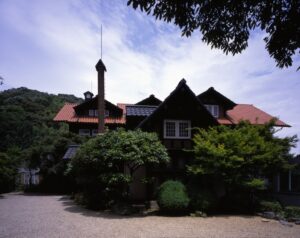
投稿タイプ:sightseeing
Asahi Group Oyamazaki Villa Museum of Art
The Asahi Beer Oyamazaki Villa Museum of Art consists of the main building, which was built between the 1910s and early 1930s, and two annexes—the Underground Jewelry Box (South Wing) and the Dream Box (North Wing), designed by architect Tadao Ando. The main building contains ceramics by Kanjiro Kawai and Bernard Leach, as well as craftworks which were born from the Japanese Mingei (folk crafts) Movement. Works by Claude Monet, including the Water Lilies series, are on exhibit in the Underground Jewelry Box. This is a museum where visitors can enjoy invaluable architecture, an exquisite garden, and beautiful works on exhibit.
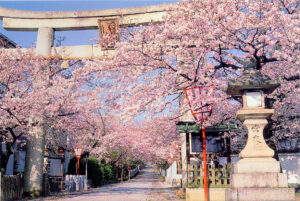
投稿タイプ:sightseeing
Mukojinja Shrine
Located in Muko City in the Otokuni Bamboo Grove area of Kyoto Prefecture, Muko shrine is an ancient shrine founded in 718 and is said to be a shrine for good harvest, academic achievement, and traffic safety.
Originally, there were two shrines on Muko Mountain、and they were later combined into one shrine and given the name “Muko shrine” that it goes by today. The main shrine, built in 1422 (Oei 29), was built in the “Sangensha Nagare-zukuri” style (three-bay wide structure with a gable roof) and has been designated as a national important cultural property.
A gentle cobblestone slope extends from the entrance gate to the main shrine. In spring, cherry blossoms are in full bloom on both sides of the over 200m path and in fall the changing autumn leaves turn the path into a colorful tunnel of red and orange.
What’s more, in April every year the "Sakura Festival" is held with events such as flower arrangement exhibitions, koto and drum performances, and bonfires are lit at night to create a different way to experience the cherry blossom from the daytime. In addition, the "Fire Festival" is held in October where Gomagi wood is burned to pray for a disease-free life and happiness.
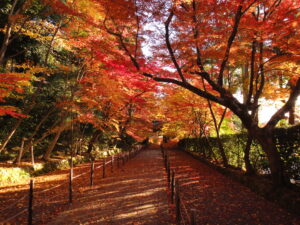
投稿タイプ:sightseeing
Komyo-ji Temple
Komyo-ji Temple was first built in 1198 by the soldier Kumagai Naozane in an area favored by his master Honen. Today, it the head temple of the Seizan sect of Pure Land Buddhism. Visitors can tour the temple itself and see the beautiful sights inside, as well as those of the garden. The temple has an excellent collection of Buddhist artwork and statues, which are on display to visitors. Inside the Mie Hall, the principal statue is papier-mâché, and it is said that Honen made it himself by dipping a letter from his mother in water.
When you enter the temple main gate, the road is divided into two. The gentle slope leading to the main hall on your right is called “Omotesando.” This approach is designed so that both women and the elderly can easily climb it and is known as the “women’s slope.” The road from “Chokushimon Gate” to “Somon Gate” on the left is commonly known as the "Maple Path," and in the fall the autumn leaves on both sides of the approach, which stretches for about 200 meters, make a brightly colored tunnel of fall colors. The path is one of the most famous spots for autumn leaves in Kyoto.
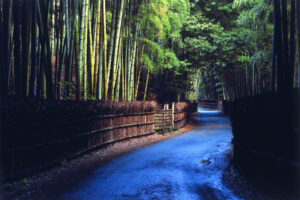
投稿タイプ:sightseeing
Take-no-Michi (The Bamboo Path)
Bamboo shoots are one of Kyoto's specialty products, but the "Otokuni" area around Muko City and Nagaokakyo City is known for producing some of the highest quality bamboo shoots in Kyoto. Take-no-Michi (the Bamboo Path) is located in the Muko hills in the northwestern part of Muko city and has a total length of about 1.8 km. The area has been improved since 2000 to preserve the scenery and promote tourism. Both sides of the road are lined by eight different kinds of bamboo hedge, including original creations such as “Takehogaki,” a hedge made of bamboo branches tied in bundles, “Kofungaki,” a hedge that looks like a rounded ancient burial mound, and “Kaguyagaki,” a hedge patterned after the neck of a 12-layered ceremonial kimono worn by Princess Kaguya, the protagonist of the folk story “The Tale of the Bamboo Cutter.”
As a result, in recent years the path is has won numerous awards. In addition to receiving the "Handmade Hometown Award" from the Ministry of Land, Infrastructure, Transport and Tourism, it has been certified by the Japan Walking Association as one of the "500 Most Beautiful Japanese Walking Paths" and "Best 100 National Walking Paths." Further, the path is designated as a "Kyoto Scenic Asset” and a “Kyoto Cultural Landscape."
Despite all the above, it is still a little-known tourist spot. You can enjoy a relaxing stroll through the bamboo forest away from the hustle and bustle while listening to the sound of the bamboo grass swaying in the wind and the chirping of small birds.
Every autumn, a light-up event called "Bamboo Path / Kaguya-no-yube (Kaguya's Evening)" is held. More than 4,500 bamboo lanterns made of candles floating in bamboo tubes filled with water are lit all over the bamboo grove. Combined with the colors of the setting sun the sight is spectacular.
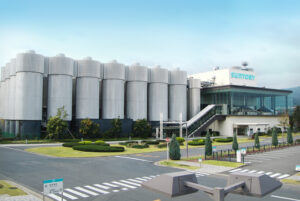
投稿タイプ:sightseeing
Suntory Kyoto Brewery
Suntory Kyoto Brewery is Suntory's second brewery, opened in 1969 in Nagaokakyo City. Around 90% of beer is made of water, so Suntory insists on building their brewery in places rich in high quality ground water. A tour of the brewery will demonstrate the process of beer production, from ingredient selection, wort production, fermentation, maturation, and filtration to packaging. At the end of the tour, there are 3 kinds of beer available for tasting (the types of beer available for tasting may change without prior notice). Other special events or seminars may take place, and inside the brewery you'll also find a souvenir store that sells the "Premium Malt's" beer and accompanying appetizers.
Guided tour: Includes explanation about each step of the beer making procedure and free beer tasting in the brewery. Available everyday except for holidays from 10:00 a.m. - 3:15 p.m. (last tour), 70 minutes each, free of charge, reservation required.